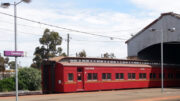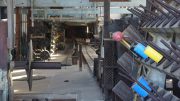Although you can hardly tell today, Geelong once had a large tram network that was the envy of many other regional towns across Australia. Since their demise in 1956, many of Geelong’s residents have lamented their lost and there have been many proposals to bring them back, but sadly as the years progress this seems little more than a pipe dream.

Geelong’s love affair with the tram began shortly after electrical power first reached our town in 1901. Back then most of the state’s infrastructure was localised and instead of relying on a huge power station in the Latrobe Valley, Geelong had its own power station located where Coles in Westfield is now located. The power station was owned by the Melbourne Electric Supply Company, despite its name this was an English company and the sum of 50,000 pounds was set aside by the London office for the construction of Geelong’s tram system in 1908.
Construction of the lines began in 1911 with the first part of the system opened in 1912 to service Geelong West and Newtown with 7 Adelaide built tram cars. The line ran from Cunningham Pier up Moorabool Street along Ryrie and Aberdeen Street until Pakington Street where the line branched off down Pakington Street to where the Telegraph Hotel is located. Another branch headed up Pakington Street and turned onto Aphrasia Street stopping just before Shannon Ave. Two lines branched off the Moorabool Street line as well to service the train station as well as a short track along Brougham Street to the tram depot at the power station.
Back in those days very few people had cars, so public transport soon became very popular as soon as it was built, Geelong was no exception and by 1913 the line was extended up Moorabool Street to the Barwon River and in 1915 three more tram cars were ordered to keep up with demand.
The line was extended to East Geelong along Ryrie Street, Garden Street and Ormond Road to Boundary Road in 1922. During the mid to late 20s the fleet of trams was increased dramatically with new tram cars being purchased from Adelaide, the USA as well as some used trams from Melbourne. In 1927 the line extended across the new Barwon Bridge to Belmont up High Street, around this time the network was completed with extensions to the Pakington Street line to Chilwell and a new line along Mercer Street and Melbourne Road to Separation Street with the last major extension to Eastern Park completed in 1930. This Eastern Park extension was popular when the cats played at home at Corio Oval, their former home ground until Kardinia Park was built in 1940.
Geelong’s tram system remained popular over the first few decades but an increasing number of motor cars and a growing city were taking its toll on the future of the system. The service to Cunningham Pier finished up in 1938 around the same time the Melbourne steamers stopped operating on the bay, themselves a victim of the modern world. The state government eventually took control of all of Victoria’s power companies in the late 1930′s including the tram systems in Ballarat, Bendigo and Geelong. Soon after as the newly formed State Electrical Commission began streamlining operations, many of Geelong’s original tram cars were swapped between the fleets of the other regional cities.
By the early 1950′s the state government had to make a decision on whether to invest in upgrades and maintenance to the ageing network or to replace Geelong’s trams with buses. Despite some protest from locals the decision was made to close the tram network with the last tram running on the Belmont line in March 1956.
Following the closure of the network many of the tram cars were transferred to Ballarat and Bendigo. Others cars were sold off and many of these have since been destroyed. Today some of the original Geelong tram cars can be found on the tourist systems that remain in Ballarat and Bendigo, while a few are located at the Melbourne Tramway Museum in Bylands between Wallan and Kilmore. One former Geelong tram has even made it to Sydney’s Tramway Museum.
Very little of the tram infrastructure remains in Geelong today and the only obvious evidence that trams existed in the city are the sign of the Melbourne Electric Supply Company above the old entry to the former depot, now home to an emergency exit of Westfield shopping centre. Most of the tracks were simply buried under the road by a layer of tar; the most recent to be removed was the line in Mercer Street and Ryrie Street during the street scaping works in 2002. Only the keen eyed tram spotter would be able to spot that there was once trams rattling down Geelong’s streets, but a tram conductor bollard was created as part of the Baywalk Bollards project and can be found near the wharf shed cafe in Steampacket Place.
Map of the Complete Geelong Tram Network circa 1956
View Geelong Trams in a larger map
We would love to hear your memories of the tram in Geelong and your thoughts on returning them to Geelong streets. Drop us a line on Twitter #IntownGeelong or Facebook IntownGeelong





